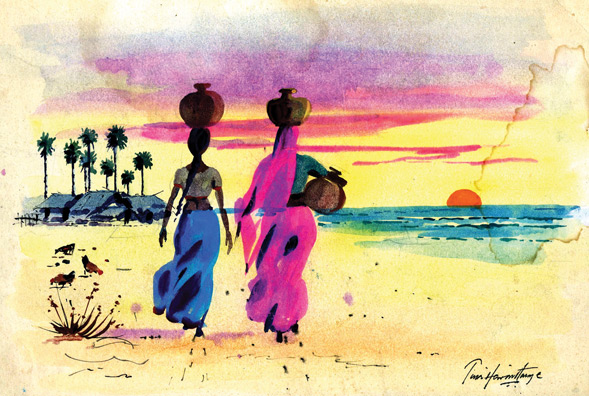Using bright watercolours
by Tissa Hewavitarane
Charming landscapes done in watercolour seems to be the impression
most people have when hearing the term “watercolour”.
Although the medium is transparent, it need not be watery or weak.
Today's artists work on paper with energy and strength, when it is
called for, to produce dynamic paintings.
 Of course, softness and subtlety are equally important at times, and
the medium adapts to those requirements. Selection of colours in a
painting is dictated by the method of working. Of course, softness and subtlety are equally important at times, and
the medium adapts to those requirements. Selection of colours in a
painting is dictated by the method of working.
Colour can be realistic adhering to nature as closely as possible or
it can be subjective with the artist using a colour that feels right at
that time.
Some watercolour books contain entire chapters on colour its use,
mixing, combination and applications to specific situations. Several
aspects of colour have special interests to the watercolourist.
Watercolour dries lighter and should therefore be applied a bit more
boldly than other paints.
Intensity
Adding this ‘extra’ bit of intensity is called ‘charging’ the colour.
Often it is done by brushing colour into a wet area of the painting,
giving it a chromatic boost. Wet a few squares and flow light washers
into them, and then charge with intense colour. Mingle the colours but
don not overwork them.
Overlaid washes often result in fascinating colour changes. A colour
can be, if it greyed too intense, by putting a complementary colour over
it or by mixing the two in the pallette. Do not, use black to tone down
intensity. Many artists never use black in their pallette, preferring to
make darker colours by mixing.
Black in student colours, often has an opaque look and tends to seem
foreign to the rest of the colours. Most inexpensive colours are rather
uninteresting in themselves, and need to be mixed to get satisfying
results.
This knowledge, only comes from practice and experimentation with
your set of colours. Muddy colours result from over work (too many
washes), from Using the more opaque colours.
Such areas can be helped or saved by lifting some shape or line out
of the area with sponge or stiff brush.
Basic theory
When I began painting as a student I bought the usual paint box with
12 colours.
While I was using small brushes it was fairly satisfactory. I soon
found, as I began to paint.
More boldly using larger brushes that the paint box became completely
inadequate. I couldn't get enough output from a student paint box or
rich enough mixtures.
The pallettes attached to the boxes were also too small so I soon
moved on to tubes, and a larger pallette to go with them, which gave me
a complete new freedom.
The next vexed question is the difference between. The very best and
expensive artists’ quality paints, which most books insist you to buy,
and the cheaper students’ quality ranges.So many people have the idea
that the cheaper quality paints would somehow fade away.
Manufacturers, who of course make both ranges, say if you keep the
permanent colours, they would both last long.
The main difference in the two ranges is the time taken to grind a
colour and of course, some of the more expensive pigments in the
artist's quality are replaced by reliable modern substitutes.
Quality
The most important is to buy from a reputed firm as it is likely that
such a manufacturer would ruin their name by selling poor quality
fugitive paint.
I have nothing against using artist's quality colour except for that
initial inhibiting factor which prevents so many people from actually
squeezing out enough paint.
However superb the quality is, if its not doing any good in the tube,
use artist's colours my colours with complete abandon and love squeezing
out plenty of paint, sometimes using it almost neat on wet paper to get
exciting soft rich bright reflects. There's no magic in the selection of
colours.
Whenever I paint the secret is to cut the number of colours down to
the bone and then learn to mix instinctively, allowing the main part of
my concentration to be devoted to solving the problem of the subject in
front of me, not wondering of my four yellows or three blues to use.
This is similar to your behaviour when driving a car. Your whole
attention is devoted to the road ahead but at the first sight of danger
your foot instinctively shoots to the right pedal without any thought on
your part.
Choice
I am still going to give you my own personal choice of colours,
whether in a rainy or misty or hot sunny day.
Rawsienna is an earth colour made from mineral oxides found in
natural soil and is one of the oldest pigments known. Artists have used
it throughout history. I use it in all sorts of mixtures and I fell it
helps me to get a sort of unity in my paintings.
Uttramarine blue is a permanent, warm and intense blue with excellent
working properties. Mixed with burnt umber it gives a very wide range of
greys by varying the proportions of each.
Burnt umber is a permanent earth brown on the cool side. Again it is
an earth colour.Light red is another earth colour and is extremely
permanent. A sort of brick red which mixes with raw sienna to produce a
lovely terracotta for titles.
Lemon yellow is a straight down to middle yellow, slightly on the
cool side and is again permanent.
Green range from nearly blue right through to near yellow.
There are cool greens and warm rich green. The first thing before you
even start to mix paint, is to learn to compare the various greens with
each other. Observe the painting titled “Sunset” down with rich bright
colours a beach scene in Jaffna. |

